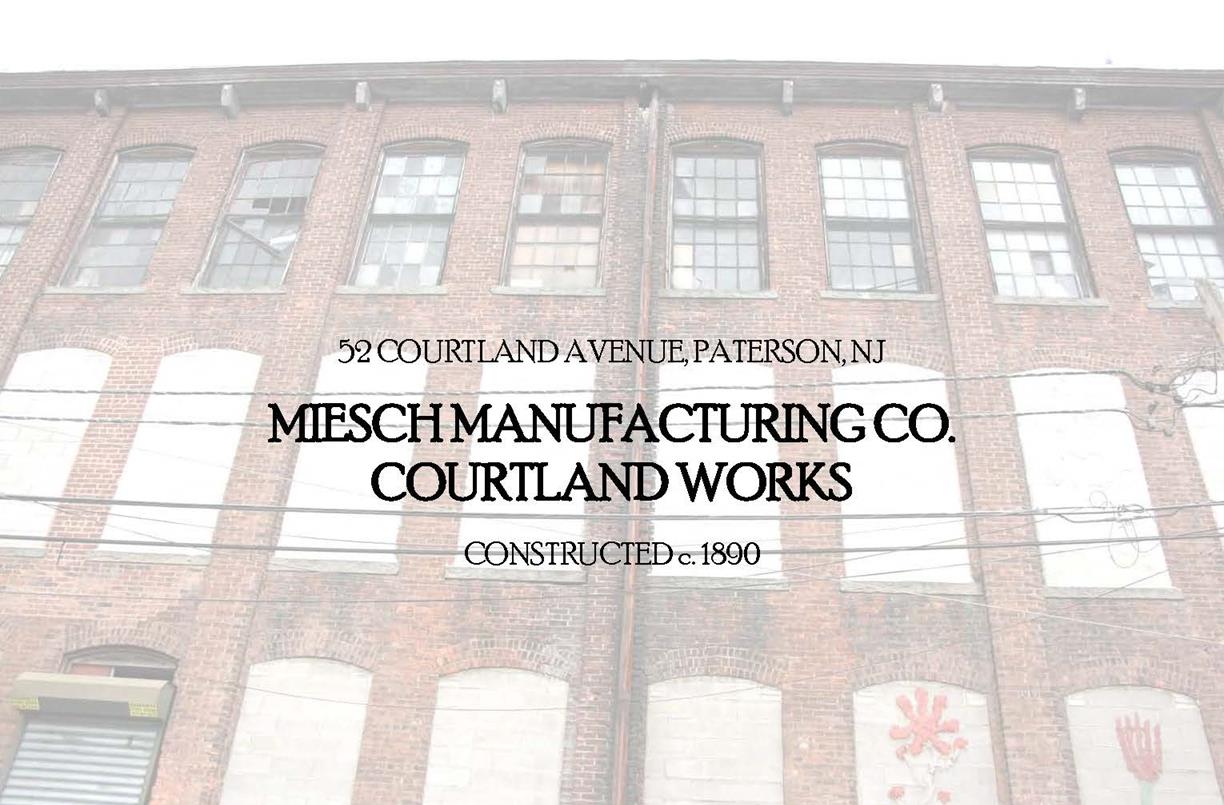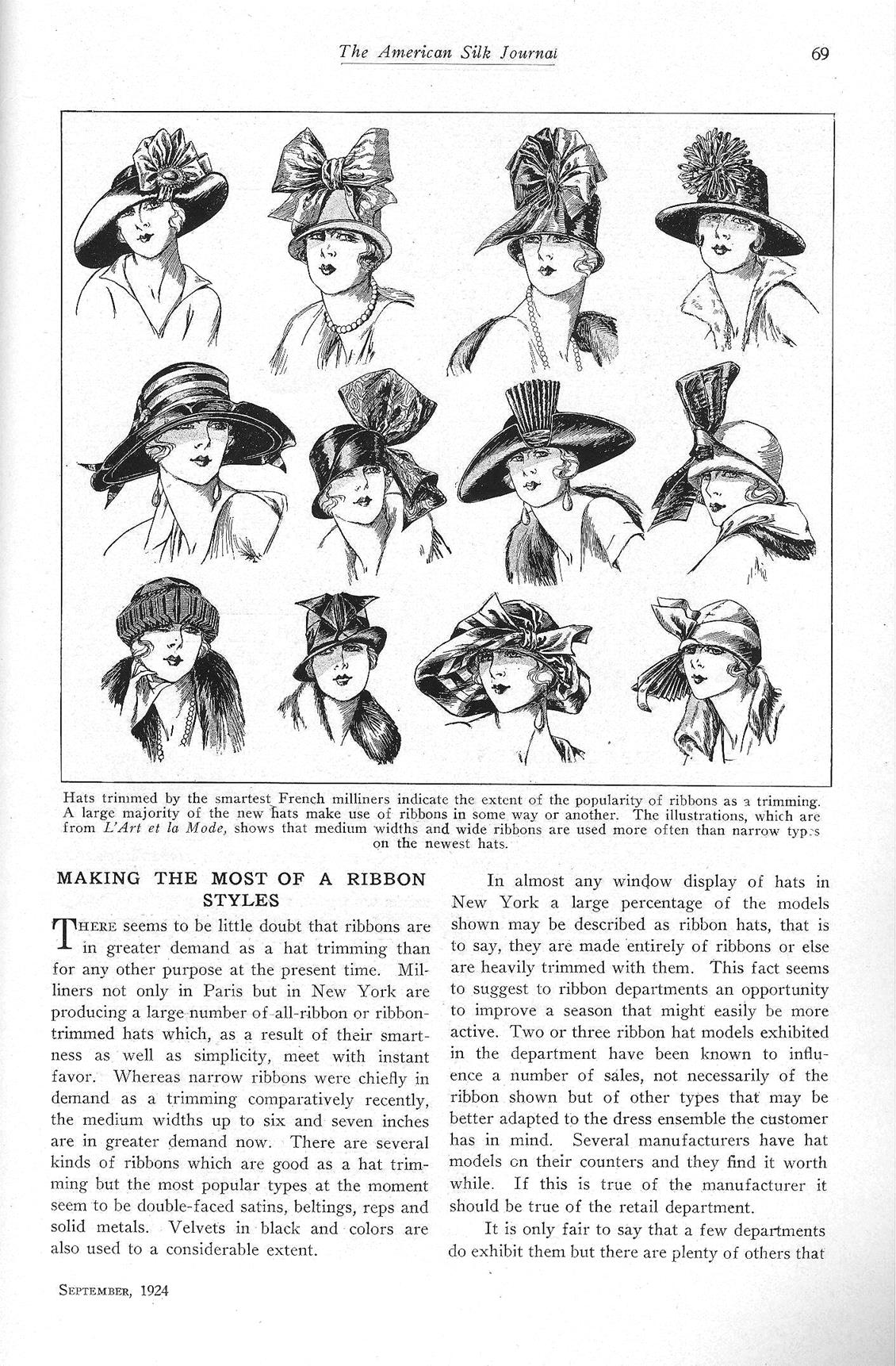
The Miesch Mfg. Co. mill located at 52 Courtland Street occupies a 1.2-acre site defined by Courtland St. on the east, Camden St. on the west, Leslie St. on the north, and Court St. on the south. The L-shaped, three story, brick and heavy timber construction mill is aligned along Camden and Leslie Streets. Contemporary ancillary buildings are extant, situated behind the main mill structures, including a two story rectangular brick shed and smaller one-story brick utilitarian buildings. The works was constructed circa 1890 in a utilitarian industrial style of evenly-spaced colossal pilasters, segmentally arched, 9-over-9 light, double hung windows. Fenestration is arranged in a rhythm of two per bay, with each bay defined by a minimal pilaster detail in the brickwork. Three further character-defining features are its three-course brick header corbelling along the eaves, center-bay loading doors for winch lifting at the gable ends, a sandstone foundation rising up along the first story to the window height along the Leslie St. elevation. This handsome building is an outstanding example of a modest, mid-sized silk mill of its period.
Map and historic evidence demonstrates a significant expansion of the Miesch Courtland Street site by more than double its size before 1915, most likely circa 1910. An addition to the first mill was made along Camden Street, forming an L-shape, and a large, rectangular plan, two-story brick utilitarian building was erected along Courtland St. A boiler house and smoke stack forming the power plant for the campus was located to the rear and in the corner of the L-shaped mills. It is also apparent from later maps that the site continued to change with smaller ancillary additions many of which are still extant, and some of which were replaced with newer, non contributing structures that remain today. An example of this is at the south end of the site, where there are several small utilitarian ancillary structures along Court St. that are not contemporary with the Miesch property. These are on a different tax parcel (Lot 2) and are not included in the boundary of the proposed designation (only Lot 1 is included).
The Miesch site today exhibits excellent integrity in its setting and fabric, with intact buildings, architectural features and detailing, including many of its double hung windows. There are few permanent alterations to the main buildings and there is great potential for preservation, rehabilitation and reuse.
Historic significance, context & association
 While only ephemeral evidence was available under the scope of this research,
the Miesch Mfg. Co. may be associated with Kaspar Miesch, a surname of likely
Austrian or Bavarian origin, that began c.1886 as a tenant in the Dale Silk
Mill on Railroad Ave. Later, the incorporation of the Miesch Mfg. Co. in 1889,
capitalization of shareholders from Philadelphia and elsewhere, allowed for the
erection of a small, 60x200 handsome mill to "manufacture on an extensive scale
all kinds of fine ribbons and silk goods that are used in the millinery trade
[hats], making a specialty of manufacturing only the finest class of goods" on
Courtland St. in South Paterson, which was expanded prior to 1915. Considering
both the expansion of the Courtland St. works and the construction of the new
works on Totowa Ave, it is possible that the John C. Welwood Corp. had
purchased the Miesch Company prior to the expansion to 468 Totowa Ave. and may
have capitalized the expansion or that the Miesch Co. constructed the new works
at Totowa and subsequently sold it to the J.C. Welwood Corp.
While only ephemeral evidence was available under the scope of this research,
the Miesch Mfg. Co. may be associated with Kaspar Miesch, a surname of likely
Austrian or Bavarian origin, that began c.1886 as a tenant in the Dale Silk
Mill on Railroad Ave. Later, the incorporation of the Miesch Mfg. Co. in 1889,
capitalization of shareholders from Philadelphia and elsewhere, allowed for the
erection of a small, 60x200 handsome mill to "manufacture on an extensive scale
all kinds of fine ribbons and silk goods that are used in the millinery trade
[hats], making a specialty of manufacturing only the finest class of goods" on
Courtland St. in South Paterson, which was expanded prior to 1915. Considering
both the expansion of the Courtland St. works and the construction of the new
works on Totowa Ave, it is possible that the John C. Welwood Corp. had
purchased the Miesch Company prior to the expansion to 468 Totowa Ave. and may
have capitalized the expansion or that the Miesch Co. constructed the new works
at Totowa and subsequently sold it to the J.C. Welwood Corp.In either case, the association with John C. Welwood Corp. is significant in that it represents the significant shift in the silk industry at the turn of the century with the proliferation of conglomerate businesses. These entities, like the J.C. Welwood Corp. based in New York City, had capitalist motivations of accumulating specifically smaller entities often built by nineteenth-century families or the previous generation of "trade expert" owners so as to capture ever smaller market shares of the times due to extreme competition, technological change and increased specialization. This and other complexities developed and contributed to the shrinking and eventual demise of the traditional silk industry in Paterson by mid century. As reported by Grace Hutchins in her book Labor and Silk (1929), a study about the Paterson Silk Strikes of 1925-26:
The Miesch Manufacturing Company, owned by the John C. Welwood Company, has just been merged with the Buser Silk Company. The two merging concerns run eleven plants in New Jersey, New York and Pennsylvania, and have now become a $3,000,000 corporation, the Miesch Manufacturing Company employing 2,000 workers. The best of the looms in the Buser mill have been moved to the Miesch plant and the old looms are discarded. The company states that all workers in the Buser factory have been taken into the Miesch mill.Advertisements for the Miesch Co. in Paterson touted association with J.C. Welwood as "sole Selling Agents" and by the mid-1920s, the Welwood Co. as "largest silk ribbon manufacturer in the world." Miesch Mfg. Co. touted its Trade Marked brand of "Olive Branch Ribbons" and mills established in Paterson, Allentown, PA, Piermont, NY, and Hallstead PA. All were "represented" by J.C. Welwood, who may have had an ownership interest through merger, or owned Miesch outright. This is also clarified by Hutchins in Labor and Silk (1929):
The non-union ribbon mills of the Miesch Mfg. Company are owned now by the John C. Welwood Corporation. The company has recently grown by a merger described in a later section. Its capitalization was increased from an original $100,000 to $1,000,000 in 1920. John C. Welwood, president of the corporation, lives on upper Fifth Avenue, overlooking Central Park. He is the largest stockholder in his company. Assets of over $3,000,000 of the concern are in ratio of about three to one of liabilities. It claims "the largest ribbon business in the world." Broad silk mills at Hawley, Honesdale, and White Mills, Pa., also help largely in building up the profits of the John C. Welwood Corporation.It is unknown when the Welwood Corp. and the Miesch Co. left the silk ribbon business, but records demonstrate that the Paterson mills were operational under the Miesch name until the mid-1930s. It is also documented in Silk and Labor that the Miesch mill workers were involved with the Paterson Silk Strike of 1925, and the appearance of Miesch and Welwood in this book was to demonstrate the eventual demise of the traditional American silk industry by demonstrating the many complexities of capitalist, markets and labor conflicts that contributed to it.
References
Guzzo, Dorothy O, "Miesch Silk Manufacturing Company (52 Courtland St.) SHPO Opinion," 1997.
Howard/Stein-Hudson Associates, "Main Line Second Track Environmental Evaluation," 1997.
Department of Community Development, "City of Paterson Survey," 1987.
Archimede, Gianfranco, "Paterson Historic Mills Group Municipal Historic Site Designations Staff Opinion of Eligibility," 2012.
Hyde, E. B. Atlas of Passaic County, New Jersey, 1877.
Robinson, E. Atlas of the City of Paterson, New Jersey, 1884
Robinson, E. Atlas of the City of Paterson and Haledon, New Jersey, 1899.
Mueller, A. H. Atlas of the City of Paterson, New Jersey, 1915.
Sanborn Map Company Insurance, Maps of Paterson, New Jersey, 1915.
Sanborn Map Company Insurance, Maps of Paterson, New Jersey, 1931.